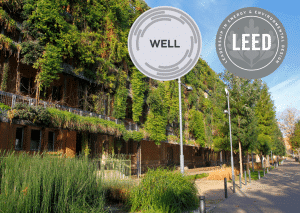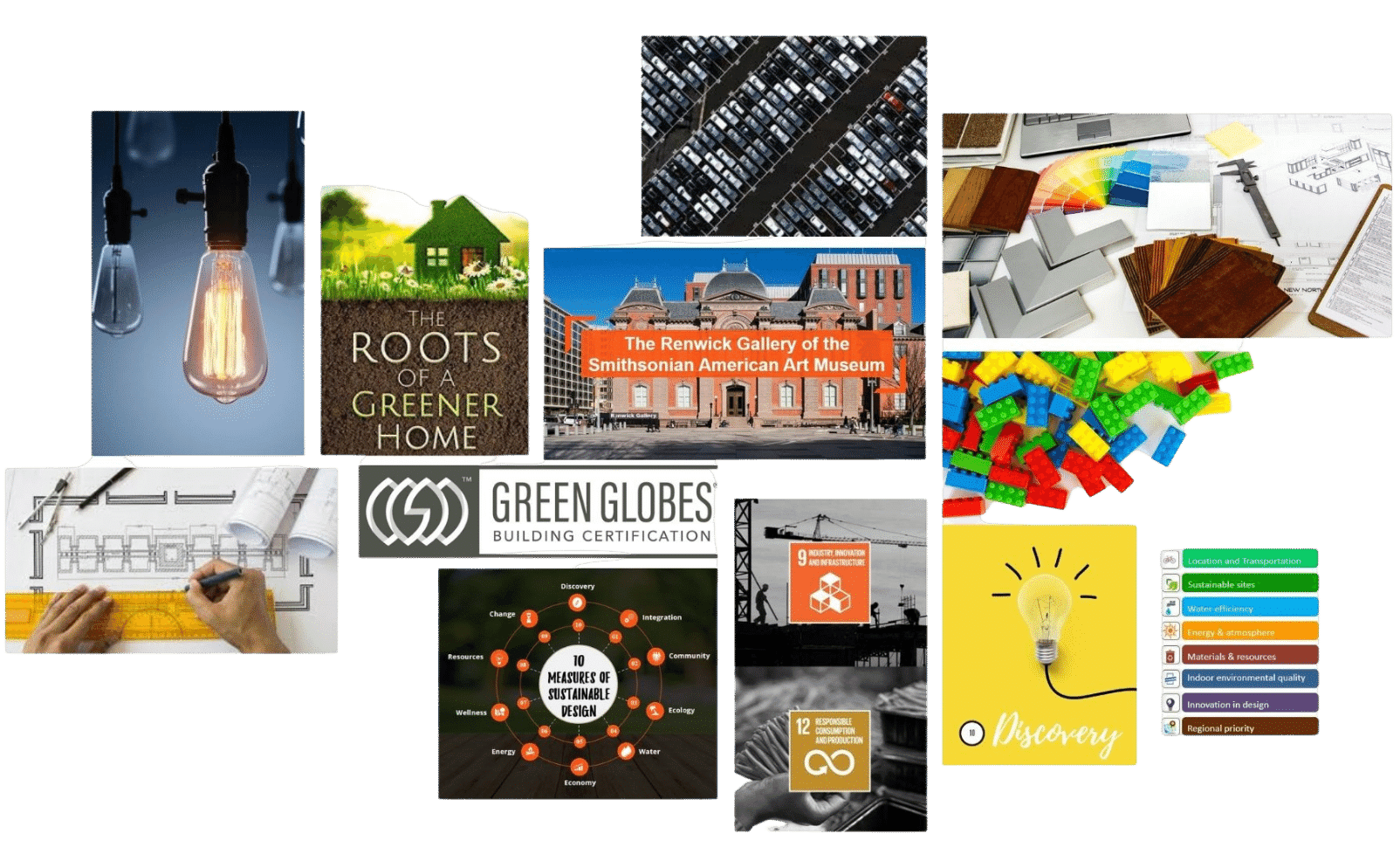In simple terms, a ‘green’ building is a building that minimizes or eliminates negative aspects and has the ability to create positive impacts on our natural environment through its design, construction and operation. Almost all green buildings are sustainable, preserve precious natural resources and improve our quality of life.
Now the question arises, how does a building become ‘green’? This is possible through creation of green building rating systems that prompt the buildings to improve their environmental performance through sustainable design and operations. Once a building succeeds in achieving a set number of parameters, it is certified as a ‘green building’.
Buildings have the potential to use — or conserve — large amounts of energy, water and materials, as well as to produce or minimize waste. In addition, they can teach us about history, art and anthropology. As a result, sustainable architecture and design is important to sustainability not only because green practices can lessen a building’s environmental footprint, but also because sustainable buildings can be used to teach those who live, work or study within them about environmental and cultural sustainability.
Popular Green Building and Sustainable Architecture Education Programs:
Popular sustainable architecture and green building programs include:
- Bachelor of Arts or Bachelor of Science in sustainability, design or architecture (or some combination thereof).
- Master of Science in sustainable design.
- Certificates in sustainable architecture
- Bachelor of Arts or Bachelor of Science in sustainability, design or architecture
The concept of sustainable design is rooted in the idea that engineering and industry can be taken in a new direction, where the long-term sustainability of a product or method is taken into account. The goal is to lessen the impact of lifestyle and commercial activities on natural resources and the environment. This is achieved through learning how to make innovative changes to current production methods and behavior models to better preserve the natural world.
Pursuing a degree in sustainable design can help students see more clearly the relationship between human activity and environmental impact. Individuals learn to sharpen their creative design skills and develop problem-solving skills. This type of knowledge can be as helpful in day-to-day activities as it is professionally.
Prerequisites for undergraduate degrees in sustainable architecture and design typically include a high school diploma or GED, including successful completion of courses in basic sciences like Earth science and physics, as well as in mathematics. Undergraduate architecture programs are typically five years long, a year longer than is required for most bachelor’s degrees.
Master of Science in Sustainable Design
Prerequisites for graduate degrees often include an undergraduate degree in a discipline related to the discipline of the desired graduate degree. For example, applicants to Harvard University’s Master in Design Studies program “normally hold a professional degree in architecture, landscape architecture, or urban planning and design. Applicants with a degree in a related discipline such as engineering, geography, computer science, or industrial design also qualify for admission. The program seeks applicants who have demonstrated overall academic and/or professional achievement in the design fields and who have the potential for advanced work in the area selected for study.”
This is a field with a great deal of diversity when it comes to careers. A Master degree in Sustainable Design could lead to work as a landscape architect, an urban engineer, or an environmental professional for a construction company. Public and private entities utilize the concepts of sustainable design to create practical ways for producing goods, designing buildings and infrastructure, and maintaining a modern lifestyle.
There are many options for institutions that offer a Master in Sustainable Design – some programs require on-campus learning, while others offer online classes.
Certificates in Sustainable Architecture
Many sustainable architecture and design professionals earn certifications like the Leadership in Energy and Environmental Design (LEED) Accredited Professional (AP) credential or the WELL AP credential.
The LEED professional exams are administered by the Green Business Certification Inc. (GBCI) for professionals seeking to earn LEED credentials. The exams test knowledge based on the U.S. Green Building Council’s LEED Rating Systems.
A LEED credential denotes proficiency in today’s sustainable design, construction and operations standards. More than 203,000 professionals have earned a LEED credential to help advance their careers. There are three different levels in the LEED Accreditation program:
LEED Green Associate
The LEED Green Associate credential is for people who have a documented, up-to-date understanding of the most current green building principles and practices. This is basically a foundational credential, and for many it is the first step before earning advanced credentials like the LEED AP with specialty.
LEED AP with specialty
A LEED Accredited Professional (AP) credential signifies an advanced depth of knowledge of green building practices and by extension, an even greater commitment towards sustainable building. Earning a LEED AP credential requires specializing in a specific field. The specialization of LEED designation resembles the specialization of graduate school. To gain higher levels of mastery in a subject, one must specialize. You can specialize in each of the different rating systems of LEED that are listed below –
- LEED AP Building Design + Construction – This rating system includes guidelines for new buildings and old buildings undergoing major renovations.
- LEED AP Operations + Maintenance – This category can be used by building owners and operators to measure operations and maintenance as well as make minor improvements.
- LEED AP Interior Design + Construction – This rating system was designed specifically for tenants leasing a portion of a larger building.
- LEED AP Neighborhood Development – This category integrates the principles of smart growth, urbanism, and green building into the first national program for neighborhood design.
- LEED AP Homes – This was specifically designed for single and multi-family residential structures that are three stories or less.
Also read: 15 Best LEED GA Exam Preparation Resources
LEED Fellows
LEED Fellows are a highly distinguished class of individuals who are nominated by their peers and have a minimum of 10 or more years of professional green building experience. LEED Fellows must also have achieved a LEED AP with specialty credential.
There are two ways to become a LEED accredited professional –
Take the Green Associate Exam and become a LEED Green Associate.
Identify your area of expertise and accordingly take the LEED AP exam to earn the LEED AP credential.
Further Reading: How to Become LEED Certified
LEED Green Associate Exam Prep
The key to earning a LEED Green Associate credential is a thorough understanding of green building practices and LEED. You can now ace the LEED Green Associate Exam with GBRI’s best-in-class all inclusive exam prep. GBRI, or the Green Building Research Institute is a proud USGBC Education Partner and one of the leading sources for affordable LEED exam prep and training in the world.
With GBRI’s study materials, you can earn your LEED Green Associate credential in as little as 5 weeks. Based on your schedule, attend the 4 week instructor-led live exam prep sessions OR utilize self-paced online on-demand exam prep modules.
GBRI LEED Green Associate Exam Prep includes:
- A study guide,
- 5 LEED Green Associate practice tests with 100 questions (each simulated just like the actual exam),
- Flash cards,
- Memory charts,
- Section wise quiz questions and much more!
- Further, the LEED v4 Green Associate online modules are also available on their website and include:
- Study Guide
- Self-Paced Online Study Modules
- Flash Cards, Memory Charts & MP3 Voice Files
- Practice Tests (sold separately)
GBRI also specializes in in-person exam preparation and training.
LEED AP Exam Prep
While pursuing the LEED AP program, it is very important to choose the credential that is in line with your field of work. As mentioned above, there are five different LEED AP courses available in which one can specialize – LEED AP Building Design + Construction (BD+C), LEED AP Operations + Maintenance (O+M), LEED AP Interior Design + Construction (ID+C), LEED AP Neighborhood Development (ND), LEED AP Homes.
There are excellent online courses available to aid in preparation for the LEED AP exams. GBRI offers all-inclusive LEED exam preparation courses for the LEED AP BD+C and O+M exams. The courses come with several features to ensure best ways to pass the exam including:
- Study Guide and Online Modules
- Practice Exams containing over 500 practice questions accompanied by explanations, increasing understanding of required principles
- Live and on-demand access for a full year
- Flashcards & Memorization Charts
- Audio Files
- Reference and study materials
- Instant access
GBRI’s LEED AP exam preparation programs include access to all LEED Green Associate study materials for students interested in taking the combined LEED Green Associate and LEED AP exam. GBRI LEED Exam Prep is taught in the context of a real LEED v4 project giving you the LEED project experience you need to ace the LEED v4 Green Associate and LEED AP Exam.
It should be noted that if you are LEED AP, you must earn 30 CE (Continuing Education) hours, out of which six must be LEED-specific, every two years to maintain your credential.
If you are a LEED Green Associate, you must earn 15 CE hours (three must be LEED-specific) every two years to maintain your credential.
WELL AP Credential
Emphasis on health and wellness is growing by leaps and bounds in every sector today, including building and architecture. Healthy interiors and wellbeing are the trending buzzwords of sustainable design.
This is why GBCI developed the WELL Accredited Professional (AP) credential in collaboration with the International WELL Building Institute (IWBI), a public benefit corporation whose mission is to improve human health and well-being through the built environment.
The WELL AP credential signifies knowledge in human health and wellness in the built environment. Once you have decided to become a WELL AP, the first step would be to sign-up for a FREE WELL online account @ wellonline.wellcertified.com.
Then, register yourself for the WELL AP exam. Click “Become a WELL AP” at the top of the page, then, scroll down and select what country you are in, and finally click “Register Now” button. You will pay and register for your exam, then, you will receive a code that you enter into www.prometric.com and pick your day and time through their website.
Prometric has testing centers in almost all major cities; so, you should be able to find one nearby.
Next comes scheduling the exam. You have 365 days or up to 1 year from the exam purchase date to schedule the exam. If you find that you need more time, you may request a single 6 month extension. Exam extensions cannot be provided after the 365 day exam eligibility period has expired.
As for WELL AP exam prep, GBRI’s study materials help you earn your credential in as little as 5 weeks. Based on your schedule and preferences, you can attend live exam prep sessions online OR utilize self-paced online on-demand exam prep modules for your convenience.
GBRI WELL AP Exam Prep Package offers everything you need to pass the exam and includes:
- On-demand Audio/Video Modules for each Knowledge Domain/WELL Concept
- Standalone Study Guide
- Practice Quizzes for each Knowledge Domain/WELL Concept
- Five (5) Mock Exams
- Memorization Tools (FREE)!
It should be noted that GBRI’s Study Guide and On-demand Modules are both stand-alone exam prep resources. Depending on your preference or learning style, you may choose one over the other.
You don’t need both the study guide and on-demand modules; however, if you prefer, you may use the study guide to complement the on-demand modules.
For example, you could start with the on-demand modules and use the guide to review what you learned or vice versa. While reviewing, pay close attention to underlined text in your study guide.
Take the practice exams after completing each module/knowledge domain/concept and review answer choices to identify topics that may need additional attention. Remember practice tests are the most helpful study tool and our customers rave about how helpful they are.
Also, note that the knowledge domains or concepts are the most important to study for the test. Understanding how many questions you can expect from each knowledge domain or concept will help identify how each section is weighed.
With inputs from:
https://www.masterstudies.com/Masters-Degree/Sustainable-Design/
https://www.sustainabilitydegrees.com/degrees/sustainable-architecture-design/











